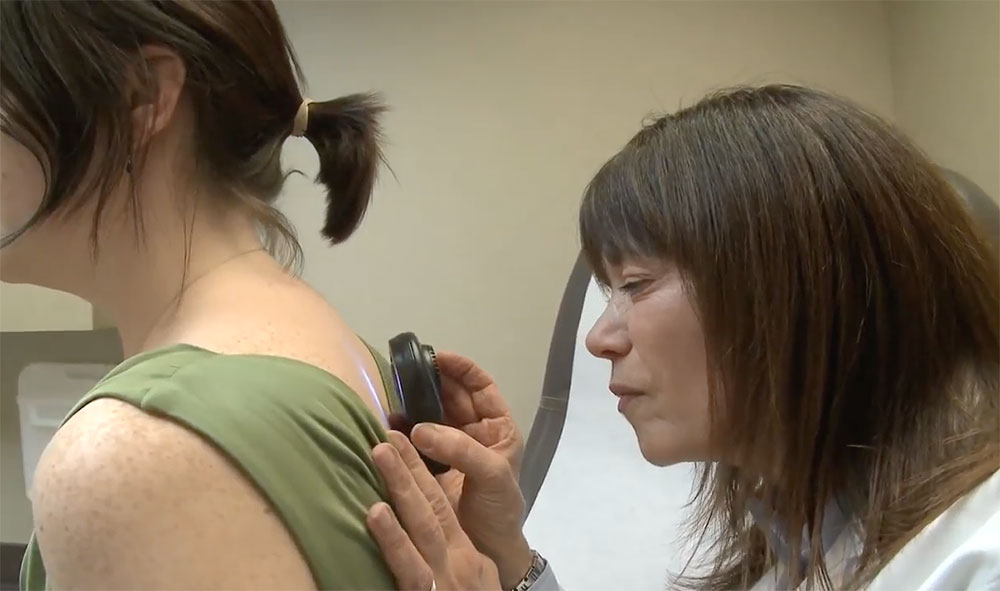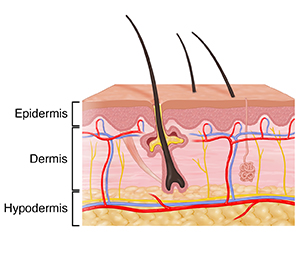Skin Cancer
The risk posed by a skin cancer diagnosis can range from mild to life-threatening. We have the expertise you need to protect, prevent, or treat against skin cancer. Our specialists use the most advanced methods to accurately diagnose skin cancer and the most innovative therapies needed to treat it.
Why choose us for skin cancer care?
BJC HealthCare offers excellent care for skin cancer, at any stage. Our Siteman Cancer Center at Barnes-Jewish Hospital and WashU Medicine, along with its five satellite locations, is designated a Comprehensive Cancer Center by the National Cancer Institute (NCI). In addition to Siteman locations, BJC HealthCare offers comprehensive and convenient care in locations across the region. Missouri Baptist Medical Center is nationally accredited by the Commission on Cancer (CoC).
We combine a comprehensive and multidisciplinary approach, research, and clinical excellence in locations designed by patients, doctors, and nurses. Decades of experience has taught us that when treating cancer, comfort and compassion are just as important as the science of medicine.
When you come to us for skin cancer care, you’ll find:
- Nationally recognized expertise: Siteman Cancer Center provides access to superior care close to home. Siteman is consistently ranked as one of the top 10 cancer centers in the nation by U.S. News & World Report.
- Groundbreaking treatments: We have innovative treatment options for every type and stage of skin cancer. These include tissue-sparing surgical techniques, topical chemotherapy, and advanced immunotherapy.
- Team-based care: Skin cancer often requires a collaborative approach. Our skin cancer team includes a variety of specialists, including dermatologists, ophthalmologists, surgical oncologists, and plastic surgeons. They work together to customize a treatment plan for you.
- Research and clinical trials: Our doctors participate in leading-edge clinical trials that help us improve treatment options. Skin cancer treatments are constantly evolving, and we are on the forefront of new therapies. Learn more about clinical trials at BJC HealthCare.
- Screening and prevention: If you are at high risk for skin cancer (because of family history or previous diagnosis), we want to keep a close eye on your skin health. That’s why we offer screening opportunities for you and your family. We use advanced methods to accurately spot skin cancer in its earlier—most treatable—stages.
- Support for you and your family: Our compassionate cancer support services team focuses on other needs you may have during and after treatment. We offer emotional support, art and music therapy, nutritional counseling, massage therapy, and more.

The Siteman approach to skin cancer
Members of your skin cancer team routinely meet to coordinate and discuss treatment options for patients. In these multidisciplinary meetings, careful consideration is given to determining the best approach to treatment.
What is skin cancer?
Skin cancer is a serious disease that can affect anyone at any age. It's the most common kind of cancer in the U.S. If found early, when it's small and hasn't spread, some of the more common types of skin cancer can often be cured. But some types of skin cancer can be life-threatening.
Talk with your healthcare provider about what you can do to help prevent skin cancer. Ask about regular skin exams as part of your routine physicals. You can also ask about doing monthly self-exams of your skin. If you see any changes in your skin, see your healthcare provider right away.
Understanding the skin
The skin is made up of three layers: epidermis, dermis, and hypodermis:
Epidermis. This is the thin outer layer of the skin. The epidermis is made of multiple layers. It's the main barrier to the world outside our bodies. It's made primarily of two types of cells: keratinocytes and melanocytes.
Keratinocytesare the most common type of cells in the epidermis. They are the structural cells of the epidermis. They are sometimes divided into several groups:
Basal cells are round cells found at the inner base layer of the epidermis. These divide to replace lost skin cells. As new skin cells are formed, they flatten and move closer to the surface of the skin.
Squamous cells are flat cells in the outermost layer of the epidermis. They are always shedding off as new ones are forming.
Melanocytes are scattered through the basal layer. They make melanin to give skin its color.
Dermis. This middle layer of skin is where blood and lymph vessels, hair follicles, oil and sweat glands, nerves, and collagen are found. It supports the epidermis and is a key part of wound healing. It also gives the skin flexibility and strength.
Hypodermis. This is the deepest layer of the skin. It's made of fat, collagen, and blood vessels. It helps insulate the body and absorb shock, and it protects the body from injury.
Most skin cancer forms in the epidermis. It usually starts in the keratinocytes or melanocytes.
Skin cancer can be grouped into two types: non-melanoma (also called keratinocyte carcinomas) and melanoma.
The two most common types of non-melanoma skin cancer are basal cell carcinoma and squamous cell carcinoma.
Basal cell cancer
Basal cell cancer is the most common type of skin cancer. It is derived from young keratinocytes, and under the microscope looks most like the round basal cells seen at the base of the epidermis. It's usually found on sun-exposed skin, like the face, ears, neck, trunk, or arms, but it can start anywhere.
These lesions vary in color and may be waxy, pearly, scaly, or scar-like. Tiny blood vessels can sometimes be seen through the lesion’s surface. These lesions can bleed easily and might not heal well. Nearly all basal cell cancers can be treated and cured if they're found early.
Squamous cell cancer
Squamous cell cancer is the second most common type of skin cancer. It is also derived from young keratinocytes, but under the microscope looks more like flat squamous cells. Lesions often form on the face, ears, neck, hands, or arms—places that get a lot of sun. The lesions are firm, red bumps or flat, scaly, crusty growths. They may be sores that keep healing and reopening.
Squamous cell carcinoma is more likely to grow and spread to other parts of the body than basal cell carcinoma, though this is rare. Most squamous cell carcinoma is found early enough to be treated and cured.
Melanoma
Melanoma is a less common but much more dangerous kind of skin cancer. It starts in skin cells called melanocytes. It's much more likely to grow and spread than basal or squamous cell cancers. Finding and treating it early is key.
It's often not easy to tell where a melanoma lesion’s borders are. It's often brown or black but may be a mix of colors with pink, tan, or white. The shape and size of melanoma lesions tend to differ from one side to the other. Melanoma is most often found on sun-exposed skin, but it can start anywhere, like the genitals, mouth, palms of hands, bottoms of feet, under the nails, and even in your eyes.
Less common skin cancers
There are other serious types of non-melanoma skin cancer, too. These include Merkel cell cancer, Kaposi sarcoma, and skin (cutaneous) lymphomas, but these cancers are very rare.
Actinic keratosis
Actinic keratosis (AK) is not skin cancer. AK develops when there is damage to keratinocytes, most often caused by too much sun exposure. It's a common, pre-cancer skin change that can turn into a squamous cell skin cancer over time if it's not treated. Most AK doesn't turn into cancer, but it's important to have any skin changes looked at by a healthcare provider.
AK lesions tend to be found on sun-exposed parts of the body. They can be pink, reddish-brown, or skin-colored. These lesions are often small, raised, scaly, and rough, like sandpaper. In some cases, AK lesions hurt. Most people with them have more than one lesion. Getting early treatment for AK almost always cures the lesions.
Search for a specialist
Our highly trained team of endocrinology specialists offer advanced treatments as well as compassionate, personalized care.
How is skin cancer treated?
Skin cancer treatment is different depending on which type of cancer you have. In many cases, we can treat early-stage skin cancers by simply removing the affected skin tissue. Sometimes, the doctor removes enough tissue during a biopsy to effectively remove all of the cancerous cells.
Other methods for treating skin cancer include:
Chemotherapy and Medical Oncology
Immunotherapy and genetics
Radiation Oncology
Surgical Oncology
Locations near you.
Skin Cancer News & Resources
Article
Shielding Yourself From the Sun: Your Guide to Effective Sun Protection
Article
